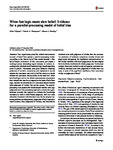When fast logic meets slow belief: Evidence for a parallel-processing model of belief bias
| dc.contributor.author | Trippas, D | |
| dc.contributor.author | Thompson, VA | |
| dc.contributor.author | Handley, SJ | |
| dc.date.accessioned | 2020-10-19T12:09:06Z | |
| dc.date.available | 2020-10-19T12:09:06Z | |
| dc.date.issued | 2017-05 | |
| dc.identifier.issn | 0090-502X | |
| dc.identifier.issn | 1532-5946 | |
| dc.identifier.uri | http://hdl.handle.net/10026.1/16556 | |
| dc.description.abstract |
Two experiments pitted the default-interventionist account of belief bias against a parallel-processing model. According to the former, belief bias occurs because a fast, belief-based evaluation of the conclusion pre-empts a working-memory demanding logical analysis. In contrast, according to the latter both belief-based and logic-based responding occur in parallel. Participants were given deductive reasoning problems of variable complexity and instructed to decide whether the conclusion was valid on half the trials or to decide whether the conclusion was believable on the other half. When belief and logic conflict, the default-interventionist view predicts that it should take less time to respond on the basis of belief than logic, and that the believability of a conclusion should interfere with judgments of validity, but not the reverse. The parallel-processing view predicts that beliefs should interfere with logic judgments only if the processing required to evaluate the logical structure exceeds that required to evaluate the knowledge necessary to make a belief-based judgment, and vice versa otherwise. Consistent with this latter view, for the simplest reasoning problems (modus ponens), judgments of belief resulted in lower accuracy than judgments of validity, and believability interfered more with judgments of validity than the converse. For problems of moderate complexity (modus tollens and single-model syllogisms), the interference was symmetrical, in that validity interfered with belief judgments to the same degree that believability interfered with validity judgments. For the most complex (three-term multiple-model syllogisms), conclusion believability interfered more with judgments of validity than vice versa, in spite of the significant interference from conclusion validity on judgments of belief. | |
| dc.format.extent | 539-552 | |
| dc.format.medium | ||
| dc.language | en | |
| dc.language.iso | eng | |
| dc.publisher | Springer Science and Business Media LLC | |
| dc.subject | Deductive reasoning | |
| dc.subject | Conflict detection | |
| dc.subject | Dual process theory | |
| dc.subject | Logic | |
| dc.subject | Belief | |
| dc.title | When fast logic meets slow belief: Evidence for a parallel-processing model of belief bias | |
| dc.type | journal-article | |
| dc.type | Journal Article | |
| dc.type | Research Support, Non-U.S. Gov't | |
| plymouth.author-url | https://www.webofscience.com/api/gateway?GWVersion=2&SrcApp=PARTNER_APP&SrcAuth=LinksAMR&KeyUT=WOS:000401445900001&DestLinkType=FullRecord&DestApp=ALL_WOS&UsrCustomerID=11bb513d99f797142bcfeffcc58ea008 | |
| plymouth.issue | 4 | |
| plymouth.volume | 45 | |
| plymouth.publication-status | Published | |
| plymouth.journal | Memory & Cognition | |
| dc.identifier.doi | 10.3758/s13421-016-0680-1 | |
| plymouth.organisational-group | /Plymouth | |
| plymouth.organisational-group | /Plymouth/REF 2021 Researchers by UoA | |
| plymouth.organisational-group | /Plymouth/REF 2021 Researchers by UoA/UoA04 Psychology, Psychiatry and Neuroscience | |
| plymouth.organisational-group | /Plymouth/REF 2021 Researchers by UoA/UoA04 Psychology, Psychiatry and Neuroscience/UoA04 Psychology, Psychiatry and Neuroscience MANUAL | |
| plymouth.organisational-group | /Plymouth/Research Groups | |
| plymouth.organisational-group | /Plymouth/Research Groups/Centre for Brain, Cognition and Behaviour (CBCB) | |
| plymouth.organisational-group | /Plymouth/Research Groups/Centre for Brain, Cognition and Behaviour (CBCB)/Cognition | |
| dc.publisher.place | United States | |
| dcterms.dateAccepted | 2016-01-01 | |
| dc.rights.embargodate | 2023-8-9 | |
| dc.identifier.eissn | 1532-5946 | |
| dc.rights.embargoperiod | Not known | |
| rioxxterms.versionofrecord | 10.3758/s13421-016-0680-1 | |
| rioxxterms.licenseref.uri | http://www.rioxx.net/licenses/all-rights-reserved | |
| rioxxterms.type | Journal Article/Review |


